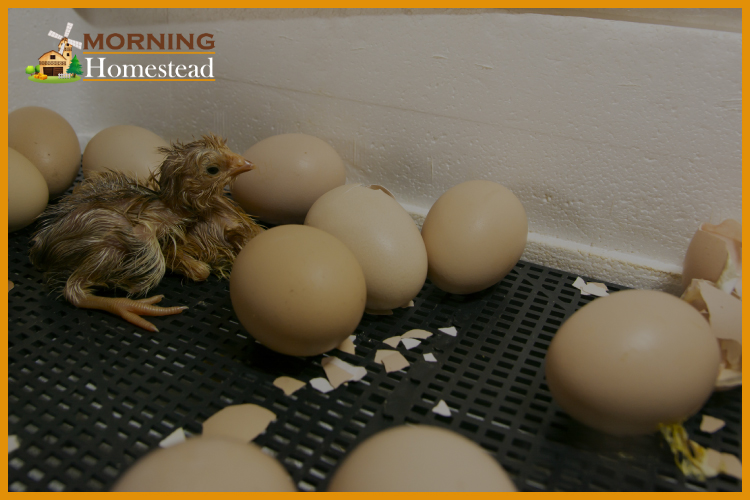Last Updated on June 9, 2023 by Georgie Smith
The ability to incubate chicken eggs is a crucial skill for every homesteader. Chickens are one of the most versatile and productive livestock on homesteads of any size, producing eggs, meat, and a good source of manure for composting. Having the skills and supplies needed to incubate your own eggs means the flexibility to increase your flock when, and as, needed.
An Incubator? Or a Broody Hen?
Many experienced chicken raisers will tell you a good broody hen is worth their weight in gold. It’s hard to argue that point. However, it isn’t always easy finding a good broody hen (some breeds like Silkies and Cochins typically make excellent broody hens). Even if you do have a good broody hen, there are pros and cons of using a broody hen versus an incubator.
Pros of Using a Broody Hen for More Chicks
- No need to turn the eggs, the hen does it for you!
- Hatched chicks quickly learn how to eat, and drink, and about predators and other risks from their mothers.
- You don’t need electricity, and the chicks are hatched outside. No need to keep them inside to incubate and brood after hatching.
- You can ‘give’ broody hen eggs as you want her to incubate (for instance, a broody hen will incubate duck or turkey eggs!).
Cons of Using a Broody Hen for More Chicks
- Good broody hens are typically ALWAYS broody. That means they will be trying to hatch eggs when you don’t want them to and they are not reliable at supplying fresh eggs to eat.
- Unless they are in a contained pen, broody hens may nest in a dangerous place, putting themselves and newly hatched chicks at risk for predators.
- Broody hens will often ‘leave the nest’ after a certain amount of the eggs have hatched, leaving some eggs with just a day or two more to go, but unhatched.
- Chicks hatched by broody hens are often more skittish and less friendly around humans.
- You must keep a rooster (for fertilized eggs) unless you purchase fertilized eggs elsewhere.
Many chicken owners that use broody hens, still own and use an incubator as well. It provides more flexibility in the case of a broody hen that isn’t cooperating, and the incubator can be utilized in an emergency. Incubators also provide more control and monitoring ability over the experience, which can be fun, especially for children.
Sourcing and Selecting Eggs to Incubate
If your flock has a rooster, then you can simply set aside some of your own fertilized eggs to incubate. If you are just starting a flock, don’t have a rooster, or want to add different breeds (or different types of poultry), you’ll need to find fertilized eggs to hatch.
First of all, how do you tell if an egg has been fertilized? Unfortunately, there is no way to know if an egg has been fertilized before you start the incubation process.
If you are sourcing from your own flock, or you have access to plenty of eggs from somewhere else, you can sacrifice a few and crack them open and see if they have been fertilized.
Typically, if you see cracked eggs fertilized, the majority of eggs from a flock will indeed be fertilized. One mating will fertilize a hen’s eggs for up to a month, so they don’t need to fertilize every egg individually.
How to Tell if An Egg is Fertilized
The simple way to tell if your eggs are being fertilized before you put in a bunch to incubate it to check for the “bulls-eye.”
On a cracked egg, you’ll see a faint ‘circle’ with a dot. That is the ‘blastoderm’ that would develop into a chick if incubated. If you just see an irregular spot that is the ‘blastodisc’ and means that egg was not fertilized.
You can also tell, after starting incubation, if your eggs are developing by ‘candling’ the incubated eggs — more about candling your eggs once they are in the incubator below.
Buying and Finding Eggs to Incubate
If you don’t have your chickens providing fertilized eggs, you can purchase some to incubate chicken eggs. The easiest way to do this is by reaching out to your local farming, poultry, and homesteading community and asking if anyone has fertile eggs. You can typically find affordable and fresh eggs easily in this manner.
If you are looking for a particular breed or type of poultry, you might need to have fertilized eggs shipped to you. You can purchase shipped eggs from commercial hatcheries. There are many different reputable hatcheries, but your best bet for buying those you can incubate chicken eggs with is to find one the closest to you (and limit shipping distance).
Another option is to contact show breeders that advertise hatching eggs. The best place to find show breeders is via the American Poultry Association. Check their club listing by breed, then find members that are located as close to you as possible.
Getting Ready to Incubate Chicken Eggs
The main thing to remember when starting incubation is to gather all your eggs together over several days and then start them all at once.
This way, all the chicks hatch at the same time. This is an advantage over the broody hen method as it is not uncommon for a broody hen to start sitting and also keep laying for several more days. This is why frequently broody hens will have many chicks that were close to hatching but don’t quite get there before the hen left the nest.
There are three main DON’TS when it comes to gathering eggs to incubate:
- DO NOT put eggs you plan to incubate in the refrigerator, keep them at room temperature.
- DO NOT wash eggs you plan to incubate. This removes the natural ‘bloom’ on an eggshell and introduces bacteria into the egg that can kill a developing chick.
- Don’t let eggs go more than seven days after being laid to start the incubation process.
What you do want to do instead:
- Choose clean, not dirty eggs to incubate.
- Store them round-side up.
- Hold them for several days at room temperature before incubating.
- If you get shipped eggs, make sure to give them a day or two before putting in the incubator.
Loading Up the Incubator
Once you’ve got everything gathered, it’s time to start incubating chicken eggs! Make sure to mark on your calendar when you put in your eggs and your hatching ‘due date’ in 21 days.
The first thing to think about is whether you will need to rotate your eggs manually, or whether your incubator does it for you. If you will need to rotate your eggs, the easiest way to keep track of this is to use a pencil to mark an “X” on one side of each egg and an “O” on the other side.
You should turn eggs at least twice a day, ideally three to even four times a day for the best results. They do not need to be turned in the last three days of the hatch.
Before putting the eggs in the incubator, turn on your incubator and run it for a day monitoring the temperature and humidity. If your incubator does not have those controls built-in, you will need to purchase separate gauges to check them.
Buy on Amazon
Each type of poultry requires slightly separate humidity and temperature, but chicken eggs do best between 99 and 102 degrees throughout incubation. If you need to check the temperature, make sure to measure at the top of the eggs.
Humidity for the first 18 days should be around 50 percent. During the last three days, it is best to raise the humidity to 65 percent to help with hatching. Check humidity levels with a hygrometer.
Candling Incubated Eggs
Candling eggs is simply the process of taking the egg into a dark space and backlighting it so that you can see the incubation development – or lack of it.
Candling allows you to identify unfertilized eggs, as well as eggs that started to develop and then stopped. Both types of eggs should be removed from the incubator, or else you risk them going rotten and exploding in your incubator and exposing the good eggs to bacteria.
All you need to candle your eggs is a dark room and a bright light. Many people just use a flashlight. However, they are lights specifically developed just for candling eggs that make the job easier by directing a strong, limited beam of light into the egg.
Buy on Amazon
You can candle your eggs every day if you like, but typically you just need to candle twice during incubation. The first time to candle your eggs is around four to six days in. You simply take your eggs into a darkened room and then place the light on the larger end of the egg. Rotate the egg slightly until you have the best view of the inside of the egg.
A network of blood vessels will appear white in an egg that has been properly developing for six to eight days. You might even see the embryo moving slightly. An unfertilized egg will appear quite clear when you handle it, with no blood vessels. Toss those eggs.
To check that your fertilized eggs are developing, candle them a second time around day 14. At this point, you are looking for eggs that started to develop and then, for some reason, ‘quit.’
A ‘quitter” will appear as a blood circle with a clearly defined red circle. This happens when an embryo dies, and the vessels separate from the embryo. You may also see dark red streaking, but that can sometimes be mistaken for a healthy embryo, so the most tell-tale sign is a blood ring. If you think you might have a ‘quitter’ but aren’t sure, mark that egg and check again in another few days.
Getting Ready for Hatch Day!
On day 19, raise your humidity level to 65 percent and place a clean cloth or paper towel under the eggs.
If you have an egg turner, remove it. If you have been manually turning eggs, stop at day 19.
Chicks will typically all hatch out within 24 hours of each other. Sometimes you will see a chick that begins to hatch but seems to stop or stall. As tempting as it is, do not assist those chicks. Sometimes they will indeed pass away and not hatch. But most often, if you get impatient and try and help them, it is easy to tear fragile membranes and do more harm than good. Chicks you assist in hatching rarely end up surviving.
Don’t worry about feeding and watering the chicks in the first 24 hours; make sure they are all hatched, leaving them in the incubator. Once your hatch appears to be finished, transfer them to a brooder that is already prepared and ready to go.
So there you have it, hopefully, this guide has given you the confidence and guidance to go and try to incubate chicken eggs on your own!





